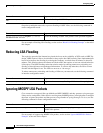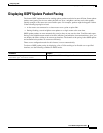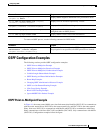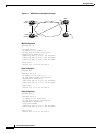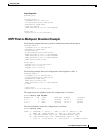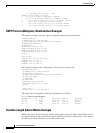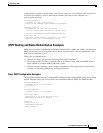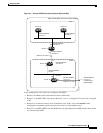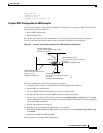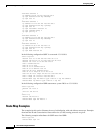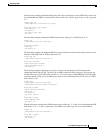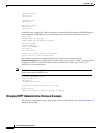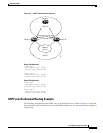
Configuring OSPF
OSPF Configuration Examples
IPC-246
Cisco IOS IP Configuration Guide
Basic OSPF Configuration Example for Internal Router, ABR, and ASBRs
The following example illustrates the assignment of four area IDs to four IP address ranges. In the
example, OSPF routing process 109 is initialized, and four OSPF areas are defined: 10.9.50.0, 2, 3, and
0. Areas 10.9.50.0, 2, and 3 mask specific address ranges, and area 0 enables OSPF for all other
networks.
router ospf 109
network 131.108.20.0 0.0.0.255 area 10.9.50.0
network 131.108.0.0 0.0.255.255 area 2
network 131.109.10.0 0.0.0.255 area 3
network 0.0.0.0 255.255.255.255 area 0
!
! Interface Ethernet0 is in area 10.9.50.0:
interface ethernet 0
ip address 131.108.20.5 255.255.255.0
!
! Interface Ethernet1 is in area 2:
interface ethernet 1
ip address 131.108.1.5 255.255.255.0
!
! Interface Ethernet2 is in area 2:
interface ethernet 2
ip address 131.108.2.5 255.255.255.0
!
! Interface Ethernet3 is in area 3:
interface ethernet 3
ip address 131.109.10.5 255.255.255.0
!
! Interface Ethernet4 is in area 0:
interface ethernet 4
ip address 131.109.1.1 255.255.255.0
!
! Interface Ethernet5 is in area 0:
interface ethernet 5
ip address 10.1.0.1 255.255.0.0
Each network area router configuration command is evaluated sequentially, so the order of these
commands in the configuration is important. The Cisco IOS software sequentially evaluates the
address/wildcard-mask pair for each interface. See the “OSPF Commands” chapter of the Cisco IOS
IP Command Reference, Volume 2 of 3: Routing Protocols publication for more information.
Consider the first network area command. Area ID 10.9.50.0 is configured for the interface on which
subnet 131.108.20.0 is located. Assume that a match is determined for Ethernet interface 0. Ethernet
interface 0 is attached to area 10.9.50.0 only.
The second network area command is evaluated next. For area 2, the same process is then applied to all
interfaces (except Ethernet interface 0). Assume that a match is determined for interface Ethernet 1.
OSPF is then enabled for that interface and Ethernet interface 1 is attached to area 2.
This process of attaching interfaces to OSPF areas continues for all network area commands. Note that
the last network area command in this example is a special case. With this command, all available
interfaces (not explicitly attached to another area) are attached to area 0.
Complex Internal Router, ABR, and ASBRs Example
The following example outlines a configuration for several routers within a single OSPF autonomous
system. Figure 42 provides a general network map that illustrates this example configuration.



